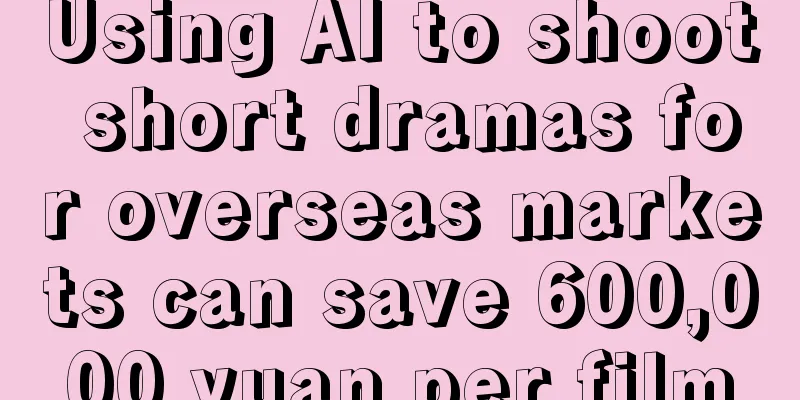Using AI to shoot short dramas for overseas markets can save 600,000 yuan per film

Last month, a short play clip using AI face-changing technology suddenly began to circulate in many short play groups and on Twitter. Using AI technology, the Chinese-looking actor in the short play was transformed into a European and American male lead, with all kinds of small expressions and demeanor quite in place. As soon as the video came out, many practitioners were very excited. On the basis of the original translated short play going overseas, this low-cost short play export model seems to be expected to go a step further in visual localization. AI short drama face-changing is even highly discussed on X | Source: X Heygen's one-second switching of languages and lip movements, combined with AI face-changing technology, can quickly deliver domestic stock short dramas overseas, solving the problem of insufficient production capacity of overseas self-made short dramas at this stage (now the top overseas manufacturers produce 4-5 short dramas a month)... It sounds like a perfect solution, but after communicating with several relevant technology service providers, we found that the reality is still relatively "skinny". First of all, AI face-changing + language/lip-sync changing is a test for domestic short dramas to be exported overseas. In other words, it is essentially a pursuit of marginal benefits. In terms of current costs, although the cost of AI face-changing is not that high, it is not low either. However, it is still uncertain how much revenue the additional investment can generate. Based on ROI considerations, short drama manufacturers still have concerns when exporting overseas. To be more specific, based on this model, face-changing improves visual acceptance, but what is more important for short dramas is the cultural background and the fit of the subject matter. Except for some globally common themes, face-changing cannot solve the problem of the plot not being localized enough. Future paid conversion is also a problem, so it still comes back to the consideration of ROI. But smart practitioners have begun to explore a new "way out" based on existing technologies and difficulties. 1. AI face-changing skit, manufacturers can’t make up their mindsAI face-changing itself is not a new technology, but it has been used more in film production, live broadcasting and other fields. It is also impressive that the first person who thought of combining AI face-changing with short dramas going global is simply a genius. The face-changing short drama mentioned above may not be the first application of AI face-changing in short dramas, but it has indeed become an opportunity for short drama practitioners to start paying attention to AI face-changing technology. Observing the circle of friends of the original author of the above face-changing video, he said that there are many people interested, and hundreds of people have been added in half a day. It sounds very lively, but after searching on TikTok, I feel that there are not many AI face-changing short dramas in the overseas market. This feeling is actually similar to that of Mr. An, a technical service provider, "There are many people waiting and watching, and few people trying the water." The reason is that they are afraid that the money invested will not be recovered. On the market, the price of AI short drama face-changing basically ranges from 50,000 to 10+0,000 yuan , and the price difference of technology is very large. "Lip-syncing translation" is basically an additional service and you have to pay more. The whole package is not a small amount. If it is done well and more comprehensively, it is very likely to cost 200,000 yuan. At present, the common practice of "domestic sales of short dramas for export" is translation, usually with foreign language subtitles. Those who are more particular will add dubbing. TTS dubbing is rare (Text to Speech, automatic text to speech), mainly because the effect is unnatural. The person in charge of Lingxiangniao Translation Company provided us with a quote. The quote for direct translation of short dramas is about 30 yuan/min (in addition to translation, the fee also includes the processes of reeling, reeling and compression output), plus 300-400 yuan/min for real-person dubbing. After this processing, the output of a single film can be controlled within 10,000 (excluding dubbing). Companies like Jiuzhou have their own AI translation system, and the cost will be even lower. According to Jiuzhou’s introduction at a closed-door meeting, their cost can be 100-200 yuan/film. Although it is a bit rough, it retains Chinese faces and voices, but overseas users can understand it. At this price, it is much cheaper to directly export domestic short dramas overseas. Although such works will have a much lower paid conversion rate when placed overseas, it is still the first choice for many manufacturers with limited budgets. Of course, it is not just a cost consideration. Another problem is that "ready-made short dramas may not suit the tastes of foreigners." This feedback is also in line with our understanding of overseas users. The cost of translating short dramas is low, but the user's enthusiasm for paying is also slightly weaker. AI face-changing can't actually solve the pain point of "plot localization" of stock short dramas. No one knows how much revenue AI face-changing can generate. The above reasons have led to the fact that AI face-changing is more of a test of "domestic sales to export" of high-quality short dramas at this stage. Large-scale AI face-changing has relatively high pressure on cost and recovery. However, in the process of communicating with many technical service providers, the author unexpectedly learned about an idea of using AI face-changing technology to make "pseudo-overseas self-made". Manufacturers bring overseas scripts to China to shoot (interpreted by domestic actors), and release the unface-changed version in China, and then release it overseas after the face-changing. In this way, the cost of AI face-changing is much lower than overseas, and at the same time it solves the problem of the plot not being localized enough. 2. “Pseudo-overseas self-made products” that customers come to us forThe high cost of overseas self-production is a problem that almost all short drama companies will mention, especially production. In the past, we have seen more cost control in this area, such as optimizing the process within the team, choosing production teams outside the United States, etc., such as switching to less developed economies in Europe, such as Romania, etc. However, the idea of filming in China and then using AI to change faces is something I have never thought of. Technology service provider Yuanmeng Space told us that this is a new business that customers came to us for. " Our initial business was to replace faces of digital humans and TV series. Recently, a lot of short drama manufacturers have approached us, about 7-8 of them, " said Zhang Xu, the person in charge. It’s not that there are no foreign actors in China, but as we have learned before, many foreign actors are already “old faces” in overseas advertisements, and there are also problems such as accents, which limits the casting. Zhang Xu introduced, “After using AI face-changing technology, manufacturers can find actors who can perform and choose any face they want.” With such a set of processes, even if the face-changing quotation of 200,000 yuan per episode is already considered a high price in the industry, it will still be cheaper than overseas self-production. The price of overseas self-production is about 150,000 US dollars to 250,000 US dollars (about 1.05 million to 1.75 million RMB). On the domestic side, even if we use the production cost of 500,000 yuan per drama, plus face-changing, the total price is 700,000 yuan, which saves at least tens of thousands of yuan. In addition, it saves time. Generally, the AI face-changing and dubbing process for a short drama takes 10 days. With this step, the domestic production cycle is still nearly a month shorter than overseas. AI short play face-changing diagram Zhang Xu said frankly that considering the cost, the face-changing technology used in short dramas will actually be somewhat different from its application in previous big-screen movies. "The quality standards of the two are different. Movies are generally 4k, and 1080p is enough for short dramas, because we still hope to control costs as much as possible." According to Zhang Xu, their finished project will be launched as early as the middle of this month, and the first batch of "pseudo-overseas self-made" short dramas powered by AI technology will soon be tested by the market. It is worth noting that the threshold for AI face-changing is not particularly high. Even novices can basically "make do" with ready-made AI tools to make a successful face-changing film. However, the processing of micro-expressions, lip matching, and the retention of skin details vary greatly. These factors have also led to huge differences in the quotations of relevant technical service providers on the market. However, overall, you get what you pay for, and manufacturers need to balance their budgets and manage expectations. Public face-changing tutorial 3. Final ThoughtsUnder the current situation of limited production capacity, short dramas going overseas have become extremely popular. It is conceivable that with the support of technical capabilities, more and more short dramas with "overseas flavor" will be launched online. For example, recently, a domestic company called Jingying Technology announced that it had received a million US dollars in financing. According to them, the video generation model has made a breakthrough and is planning to launch the first AI short drama app overseas. However, as analyzed in our previous article, the current top short drama overseas apps all have problems with low retention and betting on blockbuster products. In addition, there is homogeneity in content supply and the top products are vigorously buying traffic to wash users. We will continue to pay attention to which direction the new wave of supply will push the market. Author: Li Shuang Source public account: Baijing Overseas (ID: baijingAPP), a pan-Internet overseas service platform. |
>>: Short dramas go abroad, sinking without borders
Recommend
Where can I view Amazon's deduction details? How can I cancel Amazon's automatic deductions?
When we open a store on Amazon, if we want to unde...
How can you make money by starting a business in 2024?
The environment changes every year, and the corres...
Alibaba International Station’s laser product sales ban and restriction regulations
Laser products have been strictly controlled in ma...
With 5.28 million new users in one year, are small and medium-sized influencers taking the center stage in Douyin's e-commerce?
Small and medium-sized influencers are becoming th...
How does eBay make money? What are the techniques?
I believe that everyone is very familiar with the ...
After shutting down its welfare club which had been in operation for 9 years, has Xiaohongshu’s e-commerce reached a new turning point?
Xiaohongshu Welfare Club, which had been in operat...
What does shopeesip mean? What is its function?
Many seller friends are registering and opening st...
Franchise loss revelation: 10 million yuan to open 21 convenience stores, became the most regrettable investment
Text | Zhai Yuanyuan The last Carrefour supermarke...
How to set up free shipping on Shopee Taiwan? How to operate the site?
Now more and more merchants are opening stores on ...
A "Rose Story", a group of snickering brands
Why can a TV series make multiple brands laugh? Th...
Internet celebrities “brewing tea around the fire”: 500 yuan per person, how long will this middle-class lifestyle be popular?
A simple coal stove, an ordinary kettle, oranges, ...
What does Amazon Laobaihao mean? What are the categories?
Today I will introduce you to the content of openi...
Earn an extra 5,000 per month by writing headlines with this system!
In the Internet age, high-quality content creation...
The official account has modified its publishing rules, and non-mass articles also have the opportunity to obtain WeChat recommended traffic!
Recently, WeChat official accounts have introduced...
How to fill out an Amazon prepaid return label? What is a return label?
As one of the world's largest e-commerce platf...









